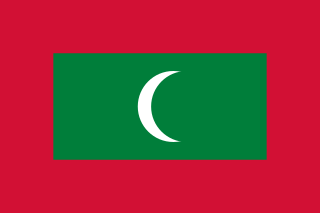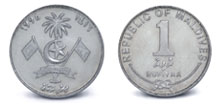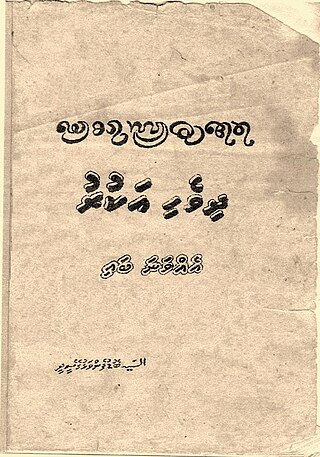Related Research Articles

The Maldives, officially the Republic of Maldives, is a country and archipelagic state in South Asia in the Indian Ocean. The Maldives is named after the main island and capital of Male. The word "Maldives" means "the islands (dives) of Male". The name may derive from the Sanskrit word "maladvipa" meaning "garland of islands". Dhivehi Raajje in Dhivehi means "Kingdom of the Dhivehi people". The Maldives is southwest of Sri Lanka and India, about 750 kilometres from the Asian continent's mainland. The Maldives' chain of 26 atolls stretches across the equator from Ihavandhippolhu Atoll in the north to Addu Atoll in the south.

Malé is the capital and most populous city of the Maldives. With a population of 211,908 in 2022 within its administrative area and coterminous geographical area of 8.30 square kilometres (3.20 sq mi), Malé is also one of the most densely populated cities in the world. The city is geographically located in the southern edge of North Malé Atoll.
Thaana, Tãnaa, Taana or Tāna is the present writing system of the Maldivian language spoken in the Maldives. Thaana has characteristics of both an abugida and a true alphabet, with consonants derived from indigenous and Arabic numerals, and vowels derived from the vowel diacritics of the Arabic abjad. Maldivian orthography in Thaana is largely phonemic.
The Maldives is an island nation in the Indian Ocean, and its music is marked mainly by Indian, East African, and Arab influences.

The Maldivian rufiyaa is the currency of the Maldives. The issuance of the currency is controlled by the Maldives Monetary Authority (MMA). The most commonly used symbols for the rufiyaa are MVR and Rf. The ISO 4217 code for Maldivian rufiyaa is MVR. The rufiyaa is subdivided into 100 laari.

Letter case is the distinction between the letters that are in larger uppercase or capitals and smaller lowercase in the written representation of certain languages. The writing systems that distinguish between the upper- and lowercase have two parallel sets of letters: each in the majuscule set has a counterpart in the minuscule set. Some counterpart letters have the same shape, and differ only in size, but for others the shapes are different. The two case variants are alternative representations of the same letter: they have the same name and pronunciation and are typically treated identically when sorting in alphabetical order.

The culture of the Maldives is derived from a number of sources, the most important of which is its proximity to the shores of Sri Lanka and South India. The population is mainly Indo-Aryan from the anthropological point of view. Islam is considered the religion of the country and only Muslims can become legal citizens.

Dhives Akuru, later called Dhivehi Akuru is a script formerly used for the Maldivian language. The name can be alternatively spelled Dives Akuru or Divehi Akuru using the ISO 15919 Romanization scheme, as the "d" is unaspirated.
In a writing system, a letter is a grapheme that generally corresponds to a phoneme—the smallest functional unit of speech—though there is rarely total one-to-one correspondence between the two. An alphabet is a writing system that uses letters.
Several Dhivehi scripts have been used by Maldivians during their history. The early Dhivehi scripts fell into the abugida category, while the more recent Thaana has characteristics of both an abugida and a true alphabet. An ancient form of Nagari script, as well as the Arabic and Devanagari scripts, have also been extensively used in the Maldives, but with a more restricted function. Latin was official only during a very brief period of the Islands' history.
Maldivian mythology or Maldivian folklore is the body of myths, tales and anecdotes belonging to the oral tradition of Maldivians. Even though some of the Maldivian myths were already mentioned briefly by British commissioner in Ceylon HCP Bell towards the end of the 19th century, their study and publication were carried out only quite recently by Spanish writer and artist Xavier Romero-Frias, at a time when that ancestral worldview was quickly disappearing.
Dhivehi Latin or Maldivian Latin, known colloquially as Malé Latin or Nasiri Latin, is a Latin Maldivian alphabet briefly mandated in the Maldives from 1976, but the country reverted to the native Thaana and Arabic alphabets in 1978. Maldivian Latin is still widely used in non-academic literature for romanizing Maldivian, however its rules are not strictly adhered to by most Maldivians.
An interpretation is an assignment of meaning to the symbols of a formal language. Many formal languages used in mathematics, logic, and theoretical computer science are defined in solely syntactic terms, and as such do not have any meaning until they are given some interpretation. The general study of interpretations of formal languages is called formal semantics.
Al-Sultana Khadeejah Sri Raadha Abaarana Mahaa Rehendhi or more famously known as just Rehendhi Khadeejah meaning, Queen Khadeejah, was the Sultana of the Maldives from 1347 to 1380. She was one of the few female rulers in the recorded history of Maldives.

The letter Shaviyani is the second letter of the Thaana abugida - the writing system used in the Dhivehi language of the Maldives and Minicoy Island.

Maldivians are an Indo-Aryan ethnic group and nation native to the historic region of the Maldive Islands, present day Republic of Maldives and the island of Minicoy in Union Territory of Lakshadweep, India. Maldivians share one culture and speak the Maldivian language, which is a member of the southern group of Indo-Aryan languages. For ethnographic and linguistic purposes as well as geopolitical reasons, anthropologists divide the Maldivian people into three subgroups.

Bodufenvalhugey Sidi or Assayyidhu Bodufenvalhugey Seedhee (1888-1970), was a Maldivian intellectual and writer.

Maldivian, also known by its endonym Dhivehi or Divehi, is an Indo-Aryan language spoken in the South Asian island country of Maldives and on Minicoy Island, Lakshadweep, a union territory of India.

Mas huni is a typical Maldivian breakfast, comprising tuna, onion, coconut, and chili. All ingredients are finely chopped and mixed with the grated meat of the coconut. This dish is usually eaten with freshly baked roshi (flatbread) and sweetened hot tea.

Old Dhivehi is the earliest attested form of the Maldivian language, recorded in Loamaafaanu in the 12th and 13th centuries CE and various Buddhist texts beginning from the 6th century CE. It is the ancestral form which gave rise to the modern northern dialect of the Dhivehi language. Old dhivehi belongs to Indo-Aryan branch of wider Indo-European language family.
References
- ↑ Bevan, Stuart (1985). Maldives. Other People Publications. p. 43. ISBN 978-0-9590626-0-1.
- ↑ Mohammed, Naashiya (2016). Dhivehi 7 (Haa) Dharivarunge Foi. National Institute of Education. p. 133,134,140. ISBN 978-99915-0-782-8.